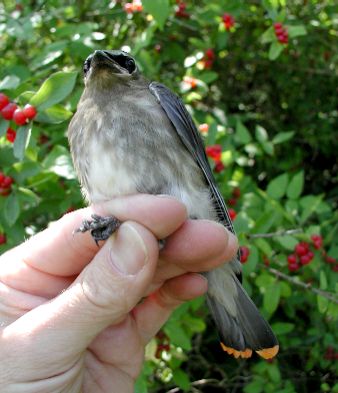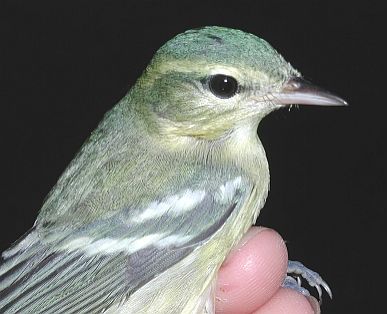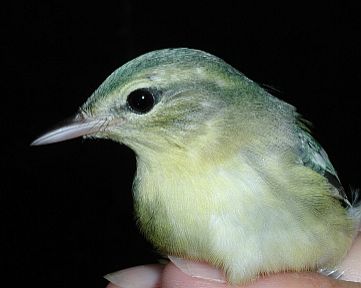PICTORIAL HIGHLIGHTS, WEEK
OF 7/21/01-7/28/01
Our banding capture rate for this week was
>50 birds/100 net-hrs., our highest capture rate since late April.
The largest number of birds caught continues to be young-of-the-year (hatching
year, or HY, in banding terminology) produced by the more common breeding
residents in and around the banding area: Gray
Catbird, Song
Sparrow, American
Redstart, and Hooded
Warbler. Increasingly, however, early
fall migrants are adding into our weekly banding list. One of the
Yellow
Warblers this week scored a maximum "3" fat
on our 0-3 scale, and another scored a "2." The two Northern
Waterthrushes banded on the last day of this
week (the first ones banded since June 1) also were migrants with visible
fat deposits.
We have just begun to catch our first HY Cedar
Waxwings (photo below right) and, as usual,
many of them are sporting orange, rather than yellow, tail bands.
This phenomenon, which we have published on (Evidence supporting
a dietary basis for orange-tipped rectrices in the Cedar
Waxwing. 1992. Journal of Field
Ornithology 63:212-216), occurs when nestling CEDWs
are fed large quantities of Tartarian honeysuckle berries (seen in the
background of the photo) while their juvenal tail feathers are developing.  A red pigment in the berries, rhodoxanthin, is molecularly very similar
to the carotenoid pigments responsible for yellow plumage and it apparently
is deposited unmodified in the growing feathers along with the normal yellow
pigments. Because of this mixing of red and yellow pigments, young
waxwings can have anything from plain yellow to light yellowish-orange
to dark orange-red tail bands.
A red pigment in the berries, rhodoxanthin, is molecularly very similar
to the carotenoid pigments responsible for yellow plumage and it apparently
is deposited unmodified in the growing feathers along with the normal yellow
pigments. Because of this mixing of red and yellow pigments, young
waxwings can have anything from plain yellow to light yellowish-orange
to dark orange-red tail bands.
At least in southwestern Pennsylvania, the
berries of this introduced but extensively naturalized honeysuckle are
available only from about mid-June to early August, after which any uneaten
berries have usually shriveled up. For this reason the orange tail
plumage variation is almost entirely restricted to juveniles here--adults
normally undergo their molt after September, when the honeysuckle berries
are no longer available in any quantity and many fruits without rhodoxanthin
are. Interestlingly, adult that lose tail feathers accidentally and
regrow them at this time of the year will often have an orange tip on the
replacement feather(s).
The Powdermill fall banding season will begin
officially on August 1, but that doesn't mean that it's too early for a
confusing fall warbler or two! See if you know this one caught today.
Click here for the answer.


<BACK
 A red pigment in the berries, rhodoxanthin, is molecularly very similar
to the carotenoid pigments responsible for yellow plumage and it apparently
is deposited unmodified in the growing feathers along with the normal yellow
pigments. Because of this mixing of red and yellow pigments, young
waxwings can have anything from plain yellow to light yellowish-orange
to dark orange-red tail bands.
A red pigment in the berries, rhodoxanthin, is molecularly very similar
to the carotenoid pigments responsible for yellow plumage and it apparently
is deposited unmodified in the growing feathers along with the normal yellow
pigments. Because of this mixing of red and yellow pigments, young
waxwings can have anything from plain yellow to light yellowish-orange
to dark orange-red tail bands.

